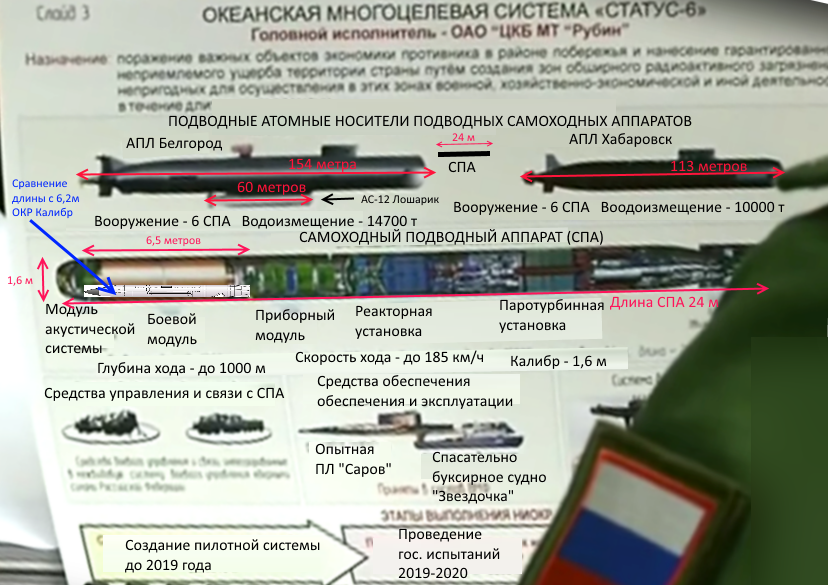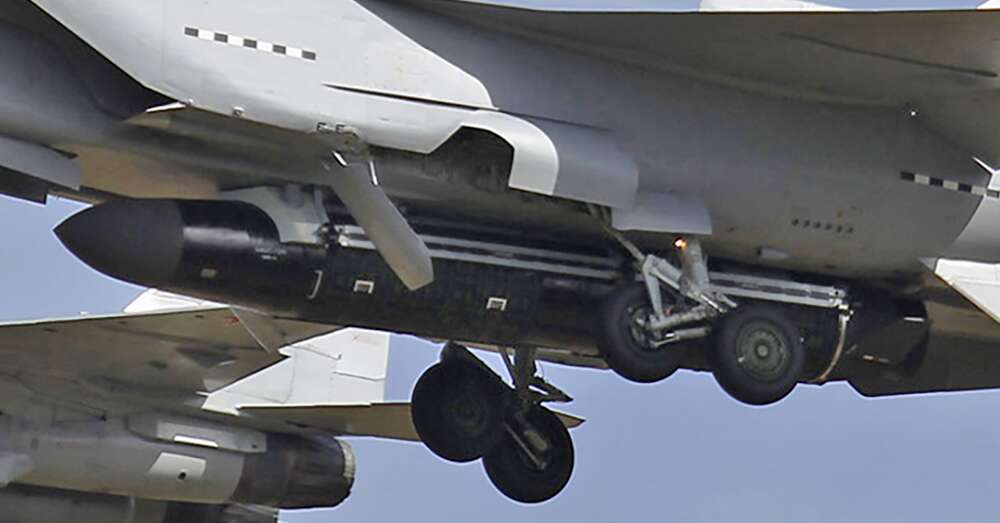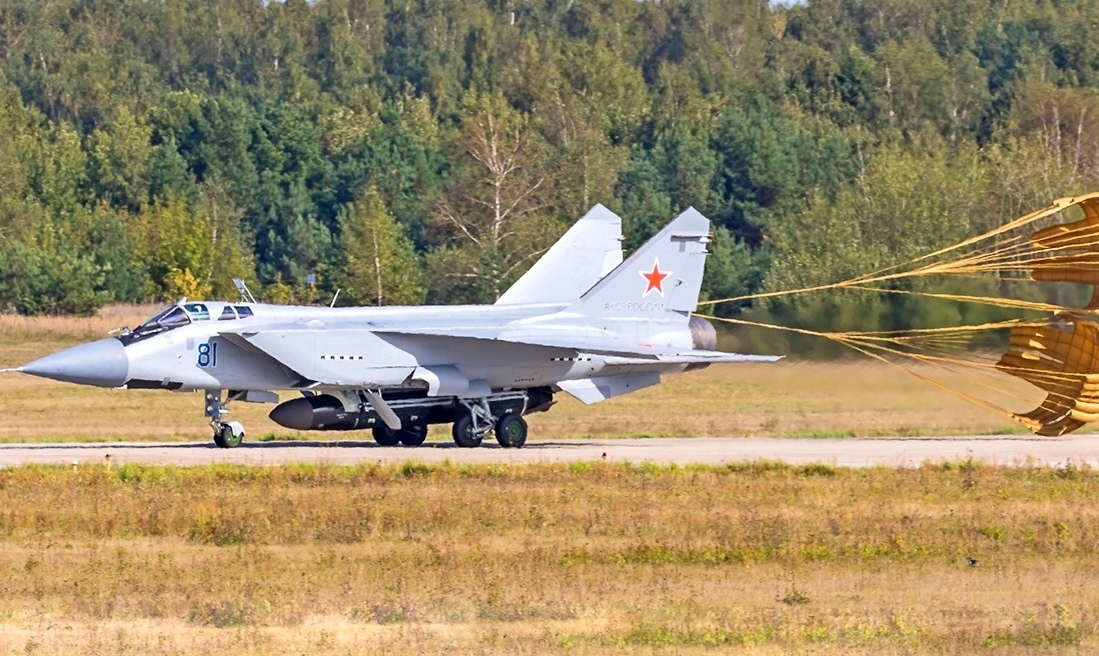http://www.janes.com/article/78685/russ ... ic-missileAlso referred to by its air-to-ground missile code of Kh-47M2, the Kinzhal has been shown being carried by, and launched from, a modified MiG-31BM supersonic interceptor aircraft.
According to Russian industry sources, the Kinzhal is based on the 9M723-1F variant of the 9M723-1 missile – as used by the 9K720 Iskander-M short-range road-mobile ballistic missile system – and modified for air-launch without major changes in its architecture.
The Kinzhal, like its 9M723-1F parent, is a solid propellant motor propelled ballistic missile with a non-separating warhead. The most obvious physical change is the addition of a finned truncated tailcone to the missile’s rear. This has been added to decrease the aerodynamic effects of the missile when carried at high-speed on the aircraft and protects both its control components and motor nozzle from damage when in transit.
To minimise the missile’s radar cross-section (RCS), no extraneous external components are located on its surface other than its two cable ducts, which run from the control/motor nozzle section, over the motor and into to the guidance section. The ducts – seen in a video presentation – are quite prominent in comparison to some seen on the parent missile, the latter far flatter and wider, with smoother transition from the motor body to the maximum height of the duct. The missile’s aerodynamic control surfaces have been revised, their planform slightly different and their aerodynamic surfaces are cleaner. It is reported that the skin of the missile has been covered with a special heat-resistant and radar adsorbing coating to minimise heat effects on it and further lower its RCS, but this cannot be confirmed.
Video - Kinzhal (10. März 2018):
https://www.facebook.com/mod.mil.rus/vi ... 324195413/
Послание Президента Федеральному Собранию (1. März 2018; VIDEO, ab )
http://kremlin.ru/events/president/news/56957
Presidential Address to the Federal Assembly
For example, the Defence Ministry and enterprises of the missile and aerospace industry are in the active phase of testing a new missile system with a heavy intercontinental missile. We called it Sarmat.
Sarmat will replace the Voevoda system made in the USSR.
That said, the capabilities of the Sarmat missile are much higher. Weighing over 200 tonnes, it has a short boost phase, which makes it more difficult to intercept for missile defence systems. The range of the new heavy missile, the number and power of its combat blocs is bigger than Voevoda’s. Sarmat will be equipped with a broad range of powerful nuclear warheads, including hypersonic, and the most modern means of evading missile defence. The high degree of protection of missile launchers and significant energy capabilities the system offers will make it possible to use it in any conditions.
Voevoda’s range is 11,000 km while Sarmat has practically no range restrictions.
As the video clips show, it can attack targets both via the North and South poles.
Russia’s advanced arms are based on the cutting-edge, unique achievements of our scientists, designers and engineers. One of them is a small-scale heavy-duty nuclear energy unit that can be installed in a missile like our latest X-101 air-launched missile or the American Tomahawk missile – a similar type but with a range dozens of times longer, dozens, basically an unlimited range. It is a low-flying stealth missile carrying a nuclear warhead, with almost an unlimited range, unpredictable trajectory and ability to bypass interception boundaries. It is invincible against all existing and prospective missile defence and counter-air defence systems. I will repeat this several times today.
In late 2017, Russia successfully launched its latest nuclear-powered missile at the Central training ground. During its flight, the nuclear-powered engine reached its design capacity and provided the necessary propulsion.
Now that the missile launch and ground tests were successful, we can begin developing a completely new type of weapon, a strategic nuclear weapons system with a nuclear-powered missile.
Roll the video, please.
(Video plays.)
You can see how the missile bypasses interceptors. As the range is unlimited, the missile can manoeuvre for as long as necessary.
Now, we all know that the design and development of unmanned weapon systems is another common trend in the world. As concerns Russia, we have developed unmanned submersible vehicles that can move at great depths (I would say extreme depths) intercontinentally, at a speed multiple times higher than the speed of submarines, cutting-edge torpedoes and all kinds of surface vessels, including some of the fastest. It is really fantastic. They are quiet, highly manoeuvrable and have hardly any vulnerabilities for the enemy to exploit. There is simply nothing in the world capable of withstanding them.
Unmanned underwater vehicles can carry either conventional or nuclear warheads, which enables them to engage various targets, including aircraft groups, coastal fortifications and infrastructure.
In December 2017, an innovative nuclear power unit for this unmanned underwater vehicle completed a test cycle that lasted many years. The nuclear power unit is unique for its small size while offering an amazing power-weight ratio. It is a hundred times smaller than the units that power modern submarines, but is still more powerful and can switch into combat mode, that is to say, reach maximum capacity, 200 times faster.
The tests that were conducted enabled us to begin developing a new type of strategic weapon that would carry massive nuclear ordnance.
Please play the video.
(Video plays.)
By the way, we have yet to choose names for these two new strategic weapons, the global-range cruise missile and the unmanned underwater vehicle. We are waiting for suggestions from the Defence Ministry.
The most important stage in the development of modern weapons systems was the creation of a high-precision hypersonic aircraft missile system; as you already know for sure, it is the only one of its kind in the world. Its tests have been successfully completed, and, moreover, on December 1 of last year, these systems began their trial service at the airfields of the Southern Military District.
The unique flight characteristics of the high-speed carrier aircraft allow the missile to be delivered to the point of discharge within minutes. The missile flying at a hypersonic speed, 10 times faster than the speed of sound, can also manoeuvre at all phases of its flight trajectory, which also allows it to overcome all existing and, I think, prospective anti-aircraft and anti-missile defence systems, delivering nuclear and conventional warheads in a range of over 2,000 kilometres. We called this system Kinzhal (Dagger).
A real technological breakthrough is the development of a strategic missile system with fundamentally new combat equipment – a gliding wing unit, which has also been successfully tested.
I will say once again what we have repeatedly told our American and European partners who are NATO members: we will make the necessary efforts to neutralise the threats posed by the deployment of the US global missile defence system. We mentioned this during talks, and even said it publicly. Back in 2004, after the exercises of the strategic nuclear forces when the system was tested for the first time, I said the following at a meeting with the press (It is embarrassing to quote myself, but it is the right thing to say here):
So, I said: “As other countries increase the number and quality of their arms and military potential, Russia will also need to ensure it has new generation weapons and technology.
In this respect, I am pleased to inform you that successfully completed experiments during these exercises enable us to confirm that in the near future, the Russian Armed Forces, the Strategic Missile Forces, will receive new hypersonic-speed, high-precision new weapons systems that can hit targets at inter-continental distance and can adjust their altitude and course as they travel. This is a very significant statement because no country in the world as of now has such arms in their military arsenal.” End of quote.
Of course, every word has a meaning because we are talking about the possibility of bypassing interception boundaries. Why did we do all this? Why did we talk about it? As you can see, we made no secret of our plans and spoke openly about them, primarily to encourage our partners to hold talks. Let me repeat, this was in 2004. It is actually surprising that despite all the problems with the economy, finances and the defence industry, Russia has remained a major nuclear power. No, nobody really wanted to talk to us about the core of the problem, and nobody wanted to listen to us. So listen now.
Unlike existing types of combat equipment, this system is capable of intercontinental flight at supersonic speeds in excess of Mach 20.
As I said in 2004, in moving to its target, the missile’s gliding cruise bloc engages in intensive manoeuvring – both lateral (by several thousand km) and vertical. This is what makes it absolutely invulnerable to any air or missile defence system. The use of new composite materials has made it possible to enable the gliding cruise bloc to make a long-distance guided flight practically in conditions of plasma formation. It flies to its target like a meteorite, like a ball of fire. The temperature on its surface reaches 1,600–2,000 degrees Celsius but the cruise bloc is reliably guided.
Play the video, please.
(Video plays).
For obvious reasons we cannot show the outer appearance of this system here. This is still very important. I hope everyone understands this. But let me assure you that we have all this and it is working well. Moreover, Russian industrial enterprises have embarked on the development of another new type of strategic weapon. We called it the Avangard.
http://en.kremlin.ru/events/president/news/56957We have achieved significant progress in laser weapons. It is not just a concept or a plan any more. It is not even in the early production stages. Since last year, our troops have been armed with laser weapons.
I do not want to reveal more details. It is not the time yet. But experts will understand that with such weaponry, Russia’s defence capacity has multiplied.
Here is another short video.
(Video plays.)
Ракетный комплекс стратегического назначения с гиперзвуковым планирующим крылатым блоком
"Strategischer Raketenkomplex mit einer geplanten hypersonischen Flügeleinheit"
Ракетный комплекс стратегического назначения Сармат
"Strategischer Raketenkomplex Sarmat"
Лазерный комплекс
"Laserkomplex"
Крылатая ракета неограниченной дальности с ядерной энергетической установкой
"Marschflugkörper mit unbegrenzter Reichweite und Kernreaktor"
Океанская многоцелевая система с беспилотными подводными аппаратами, оснащенными ядерной энергетической установкой
"Ozeanisches Mehrzwecksystem mit unbemannten Unterwasserfahrzeugen, ausgerüstet mit einem Kernreaktor"
Авиационный ракетный комплекс Кинжал
"Flugzeuggestütztes Lenkwaffensystem Dolch"
http://vote.mil.ru/
Vor mehr als zwei Jahren wurde eine Grafik veröffentlicht, die nahelegt, dass das "Ozeanische Mehrzwecksystem" von CKB Rubin gefertigt wird:

https://www.brookings.edu/blog/order-fr ... r-torpedo/









